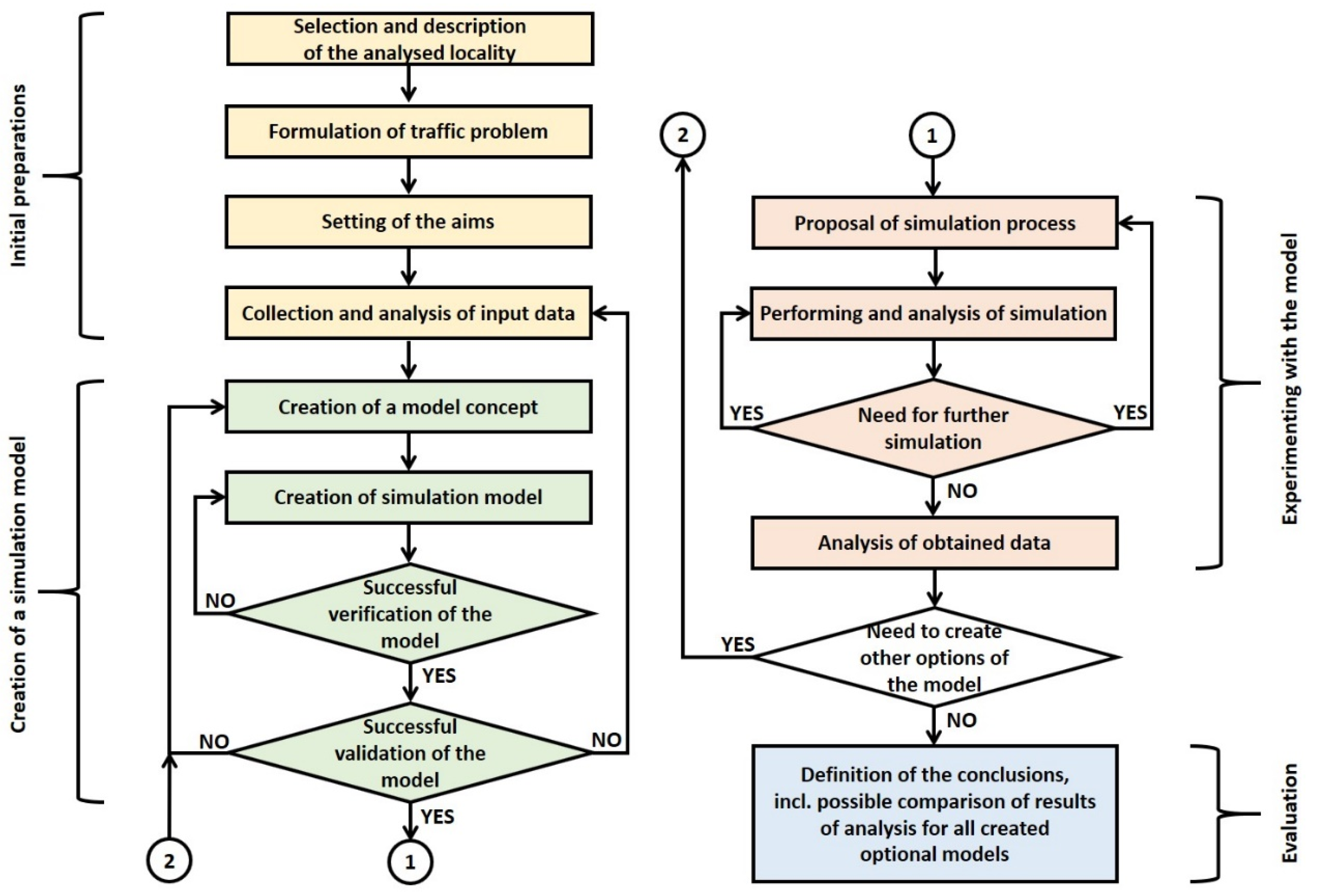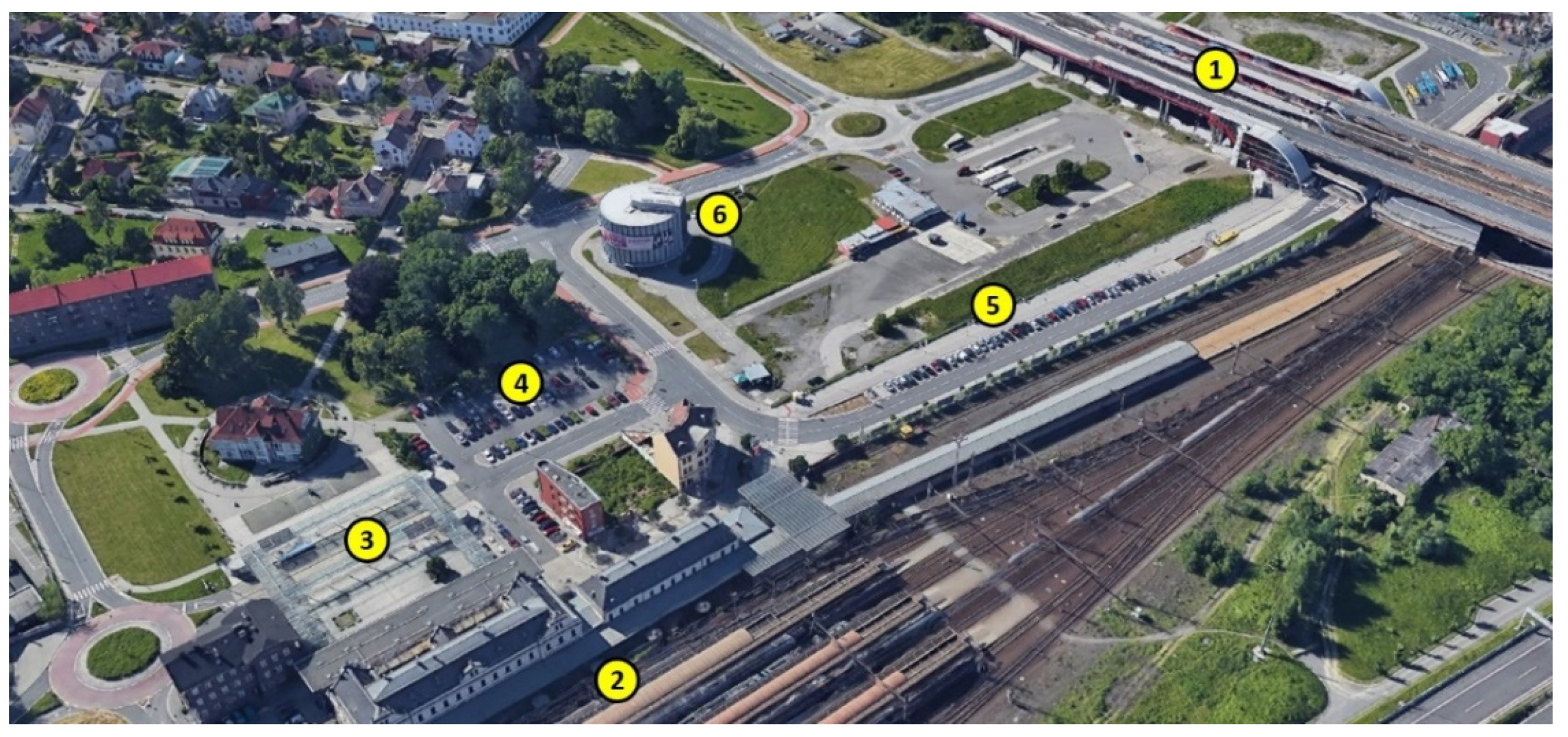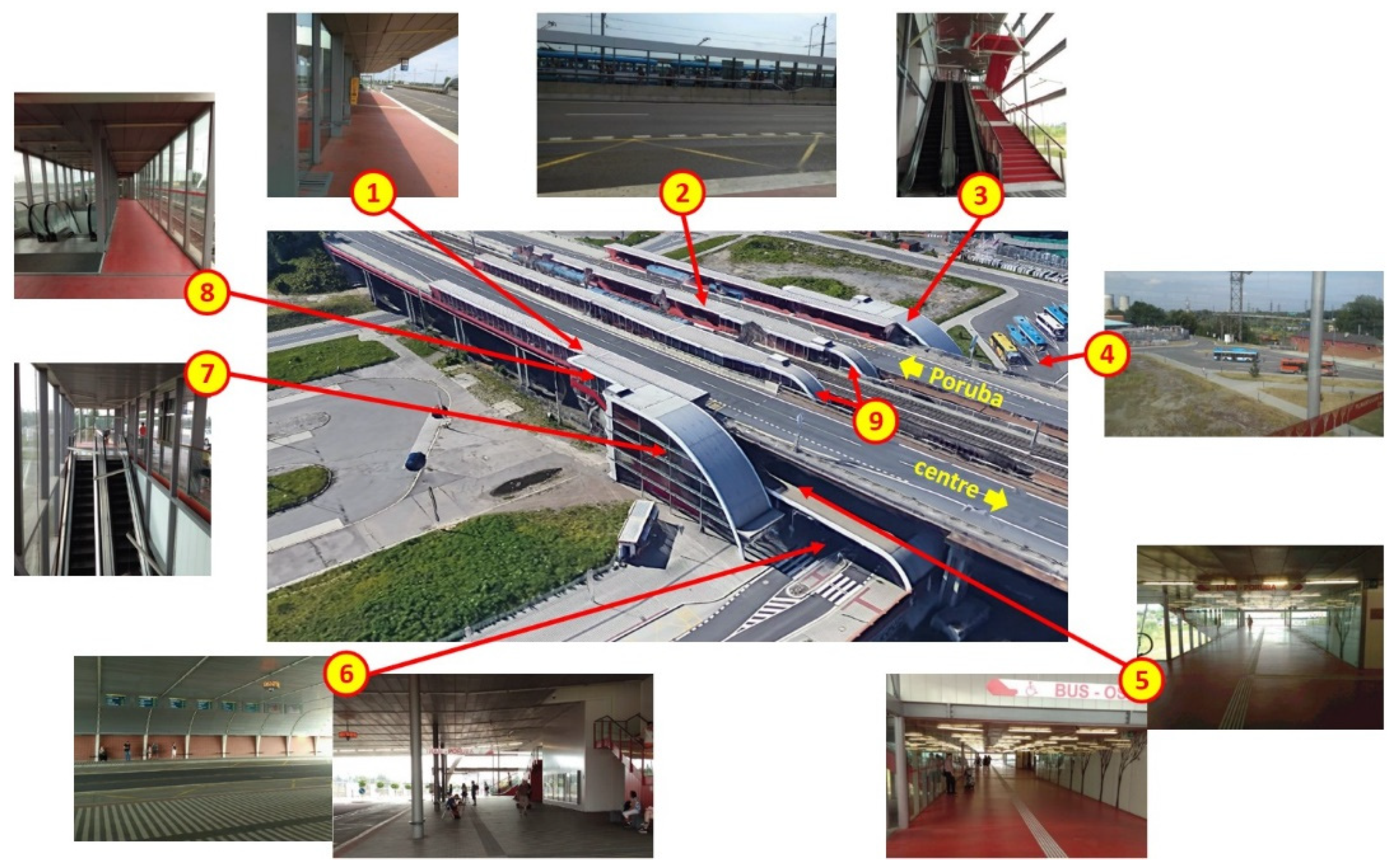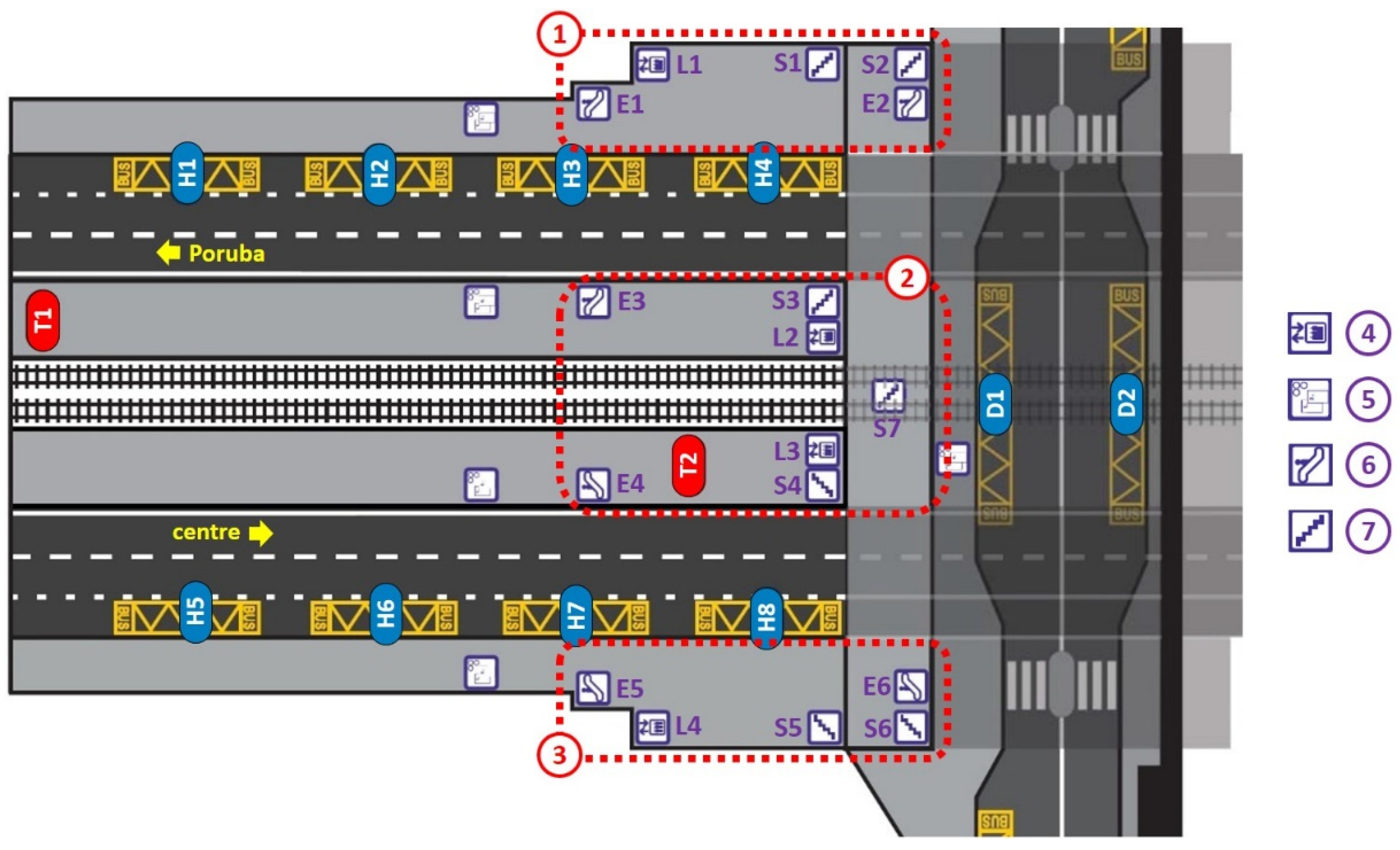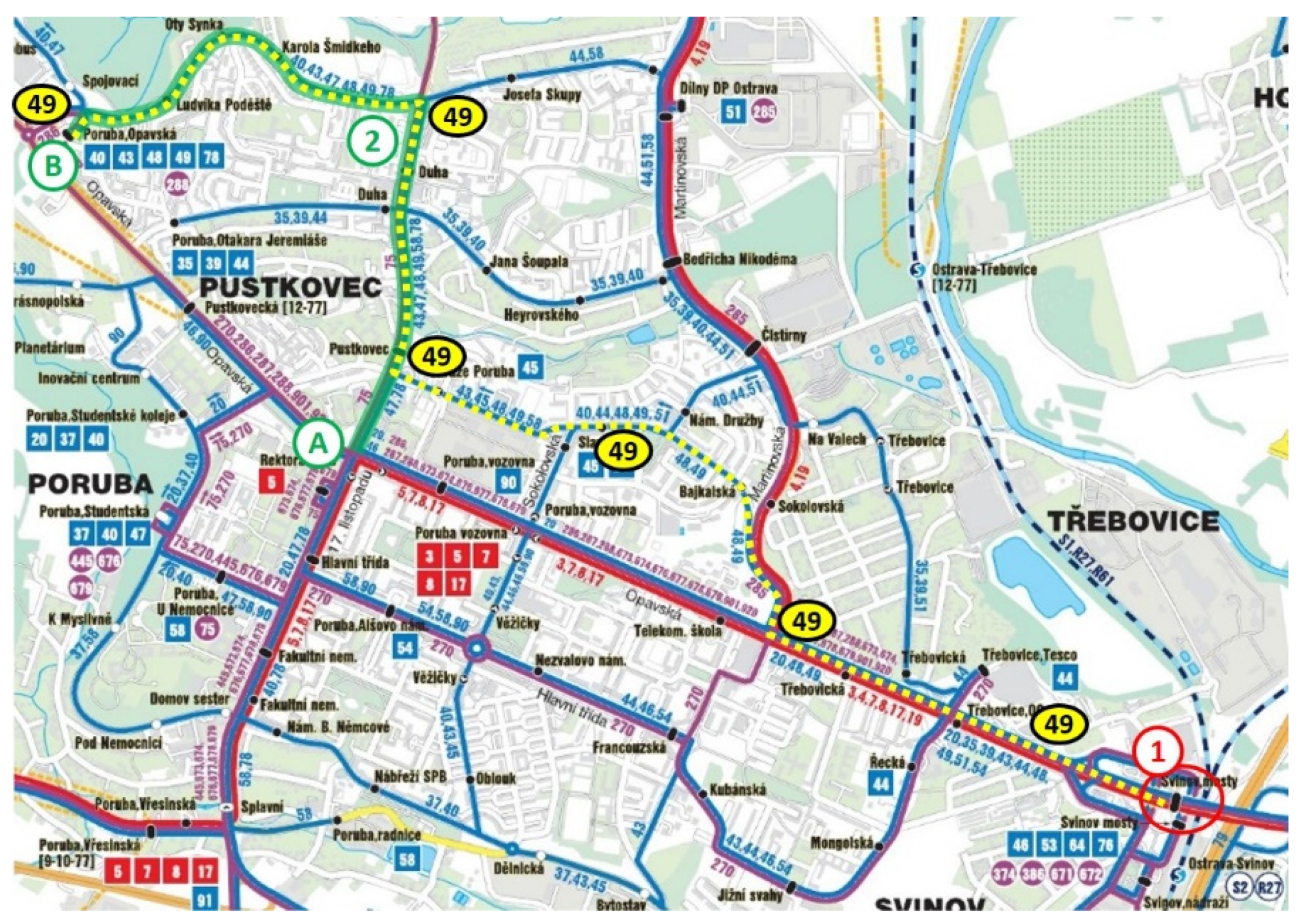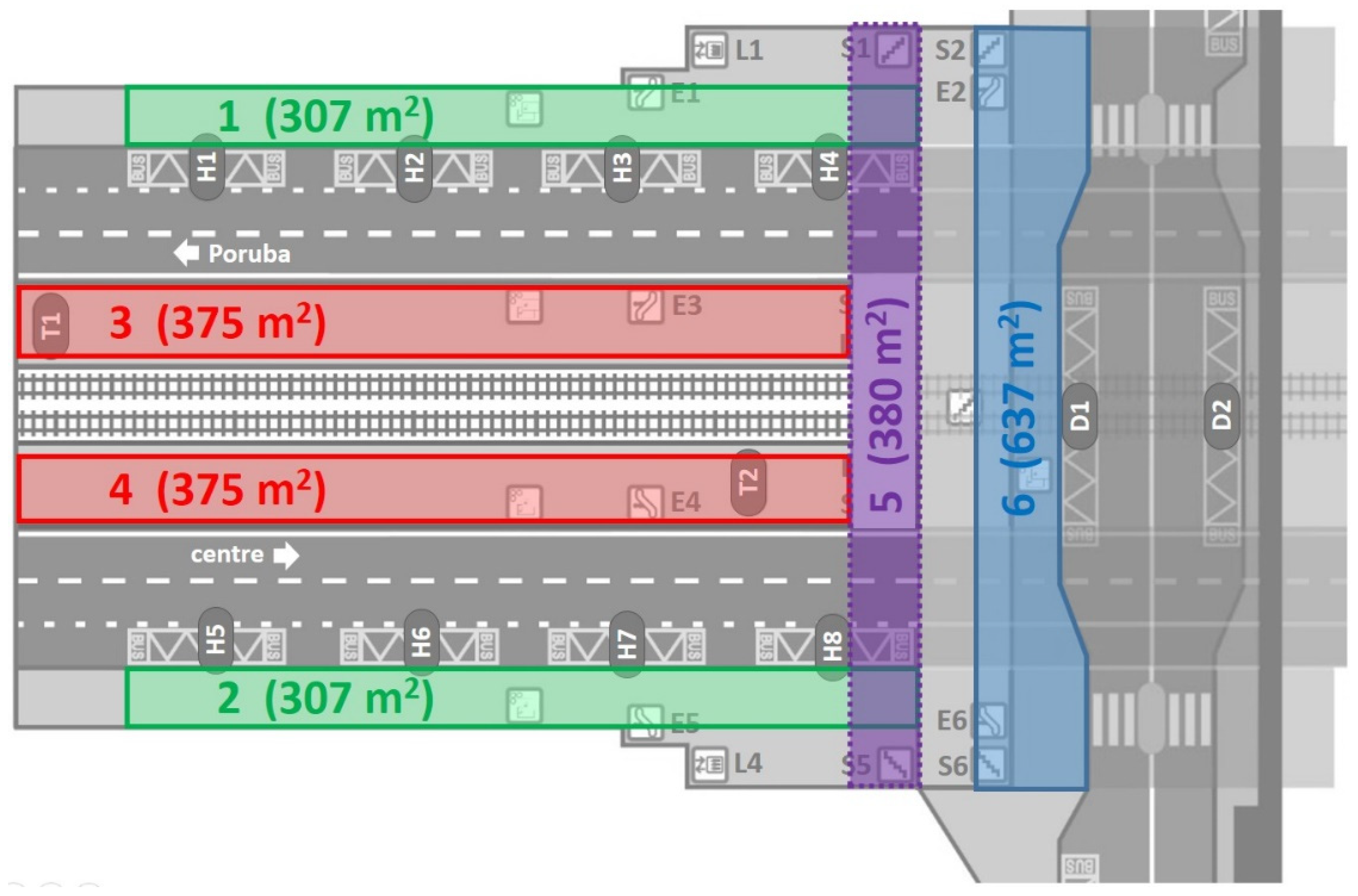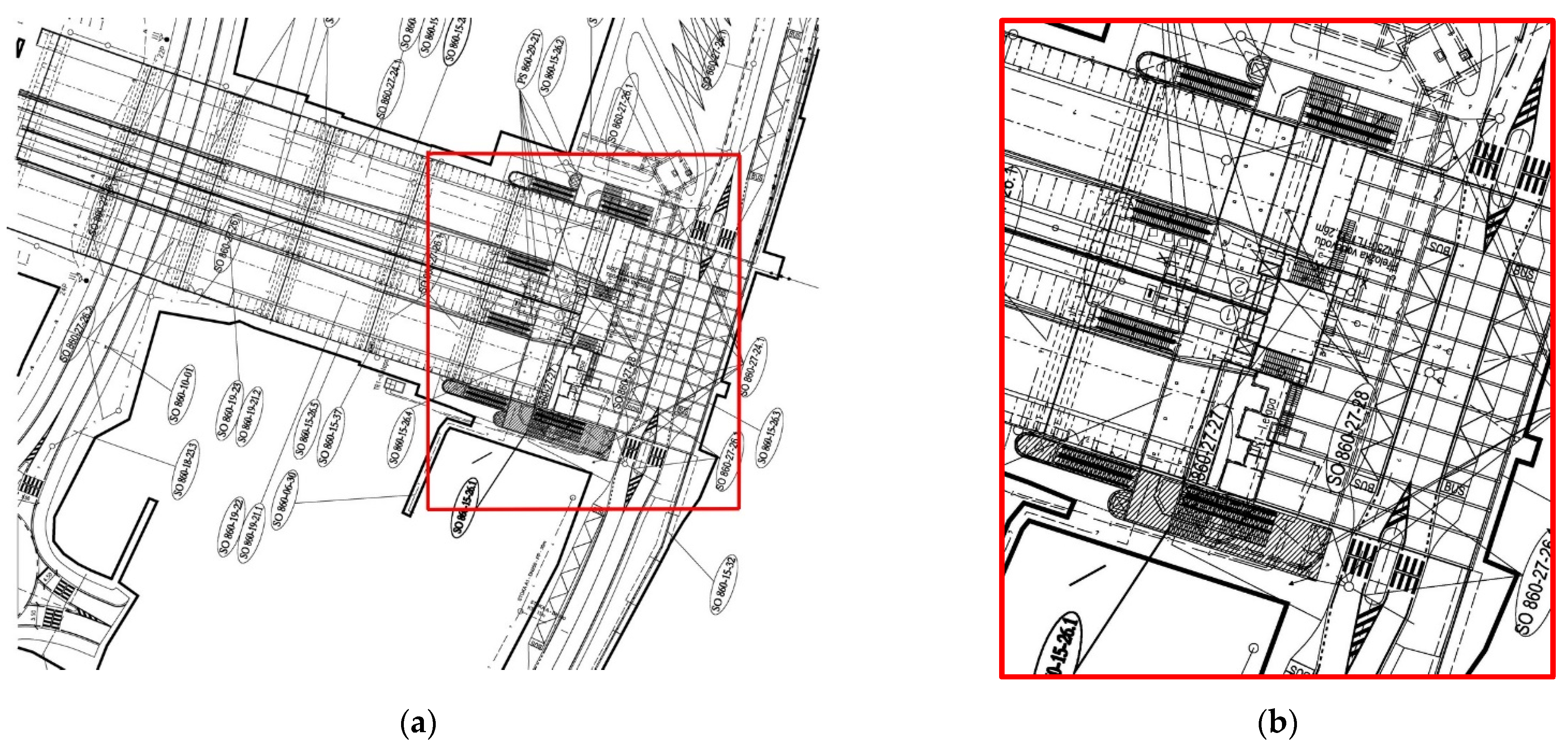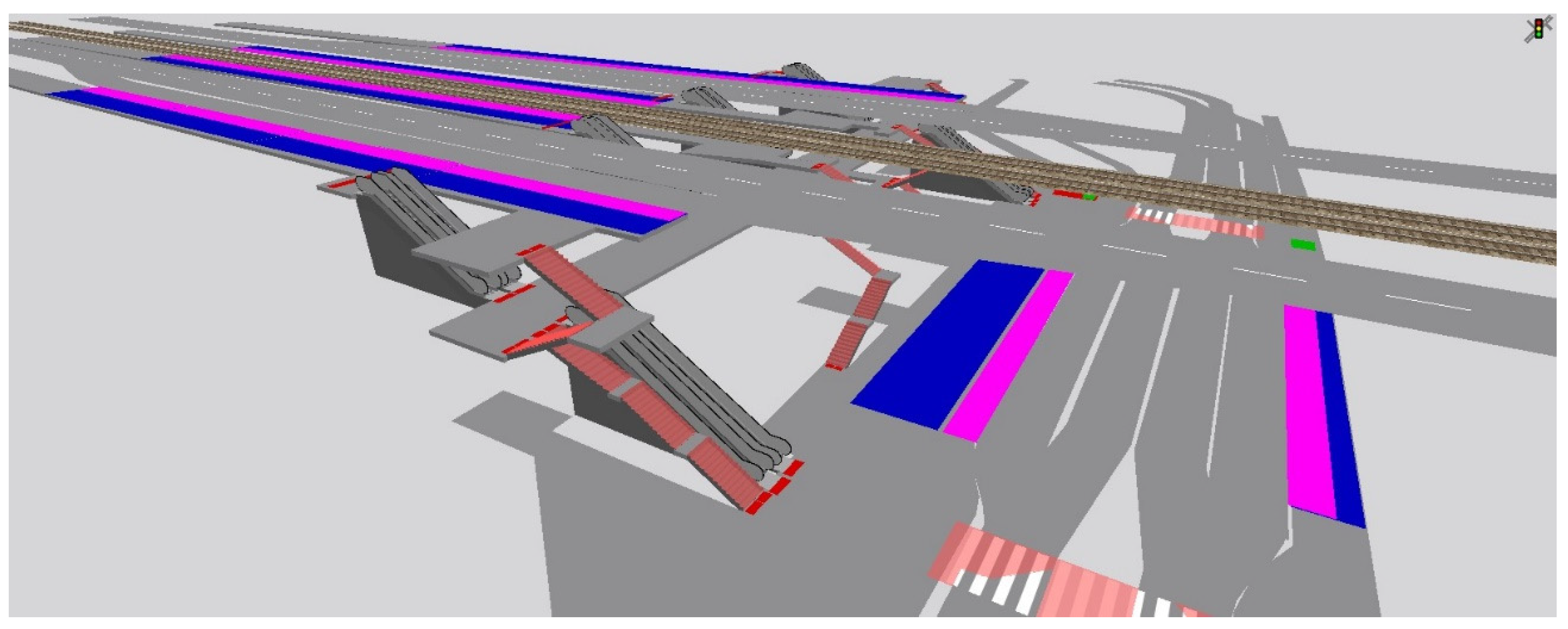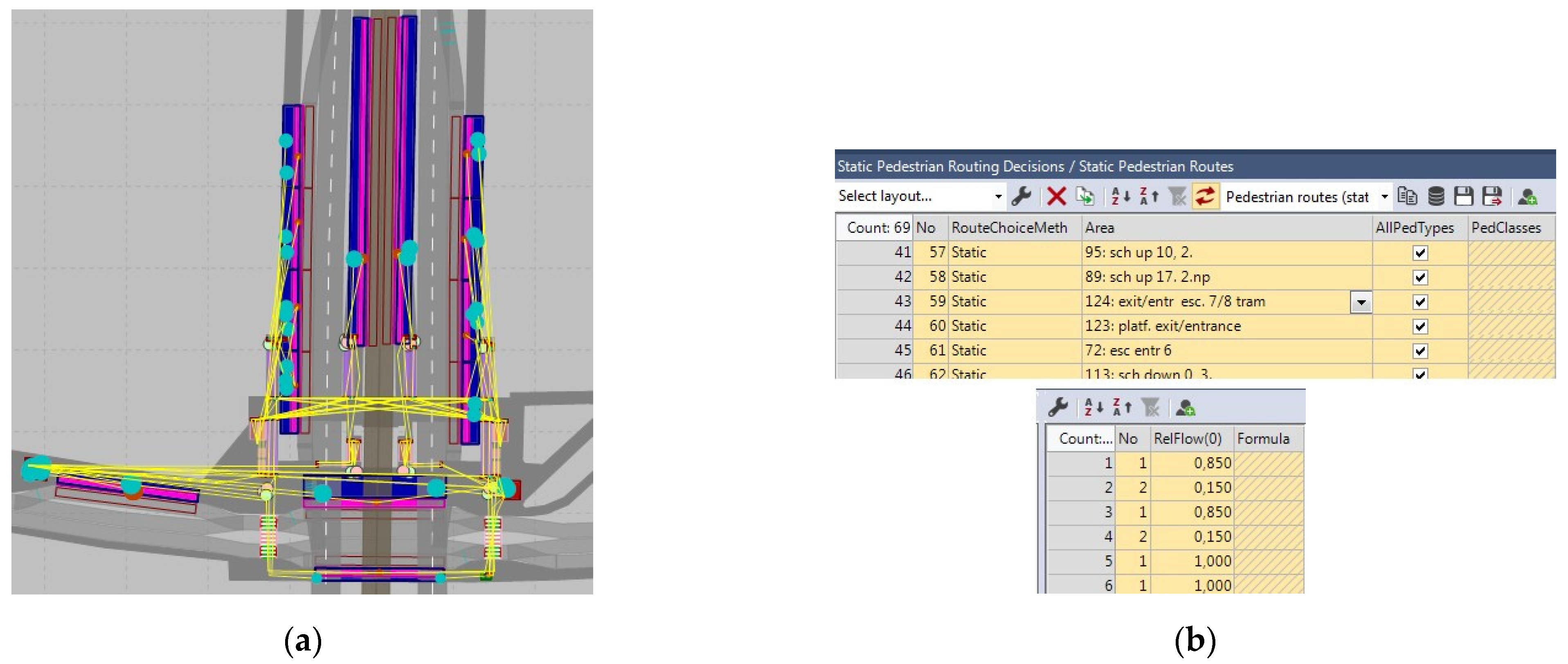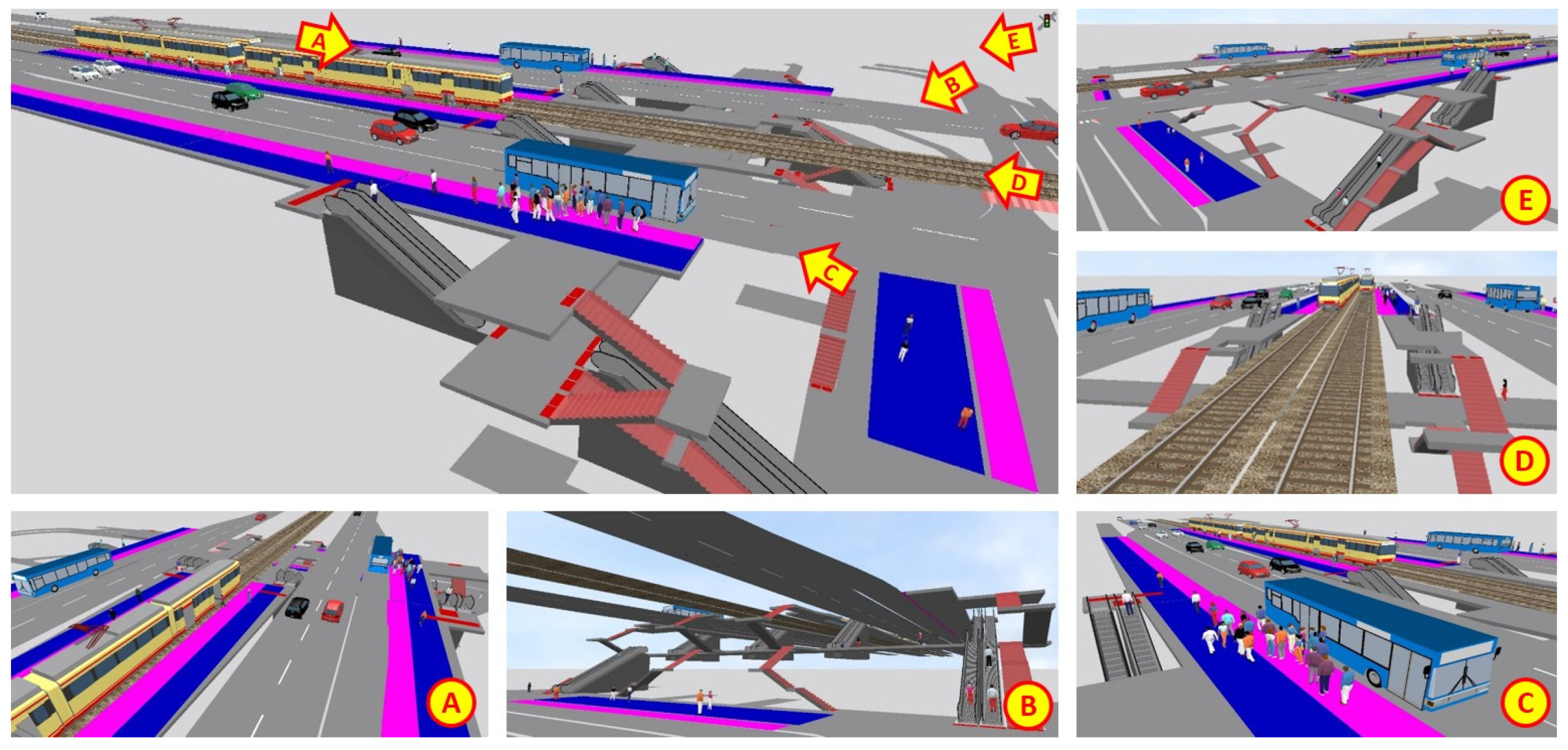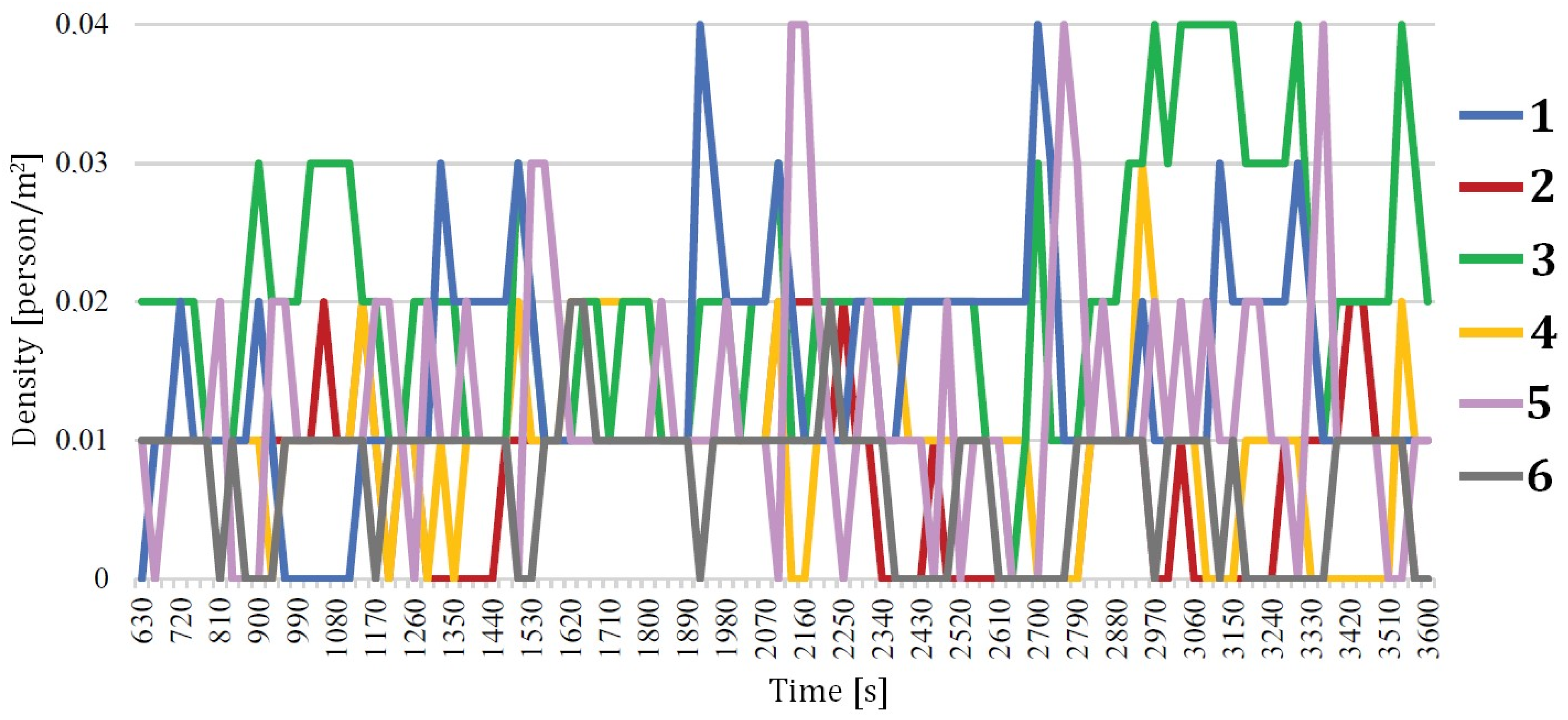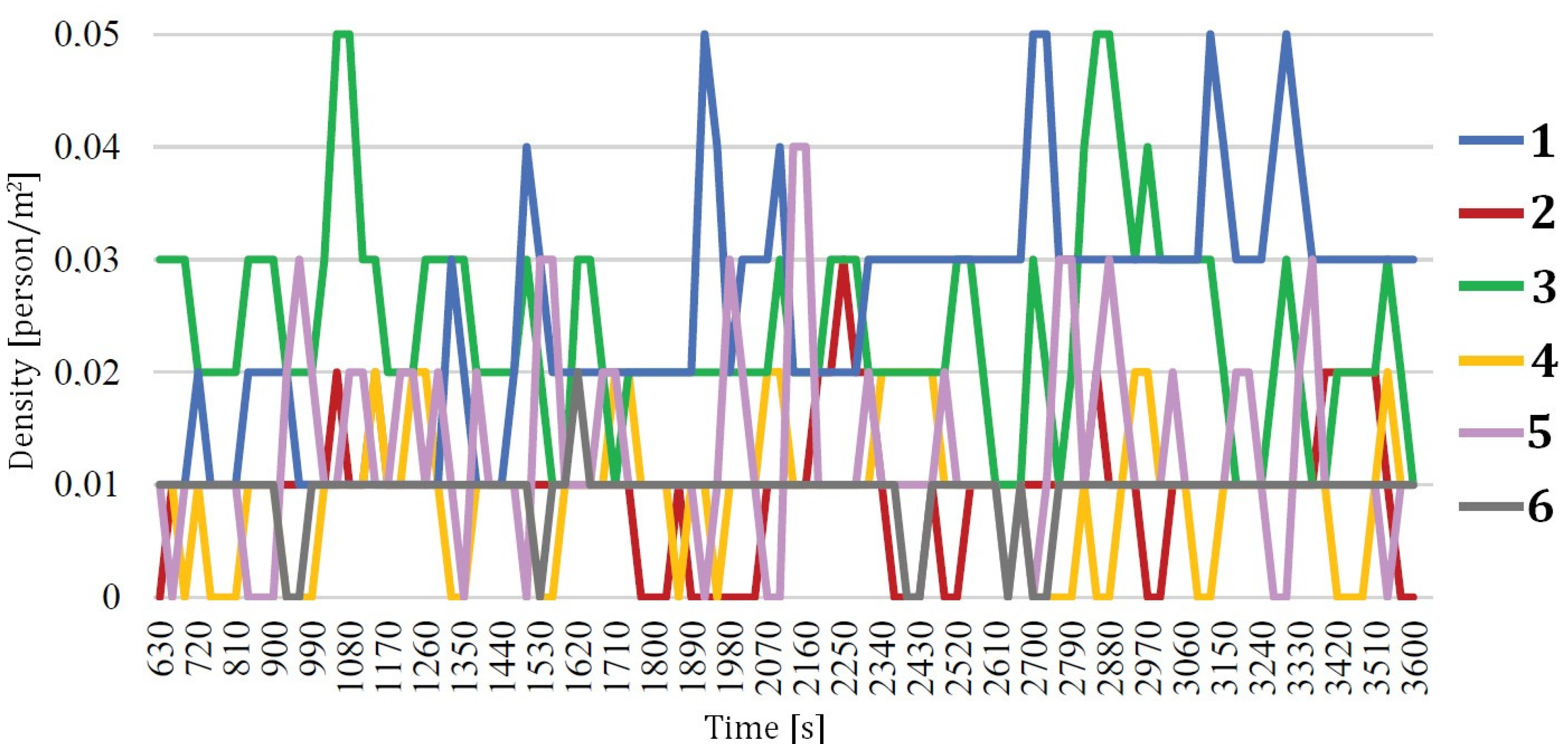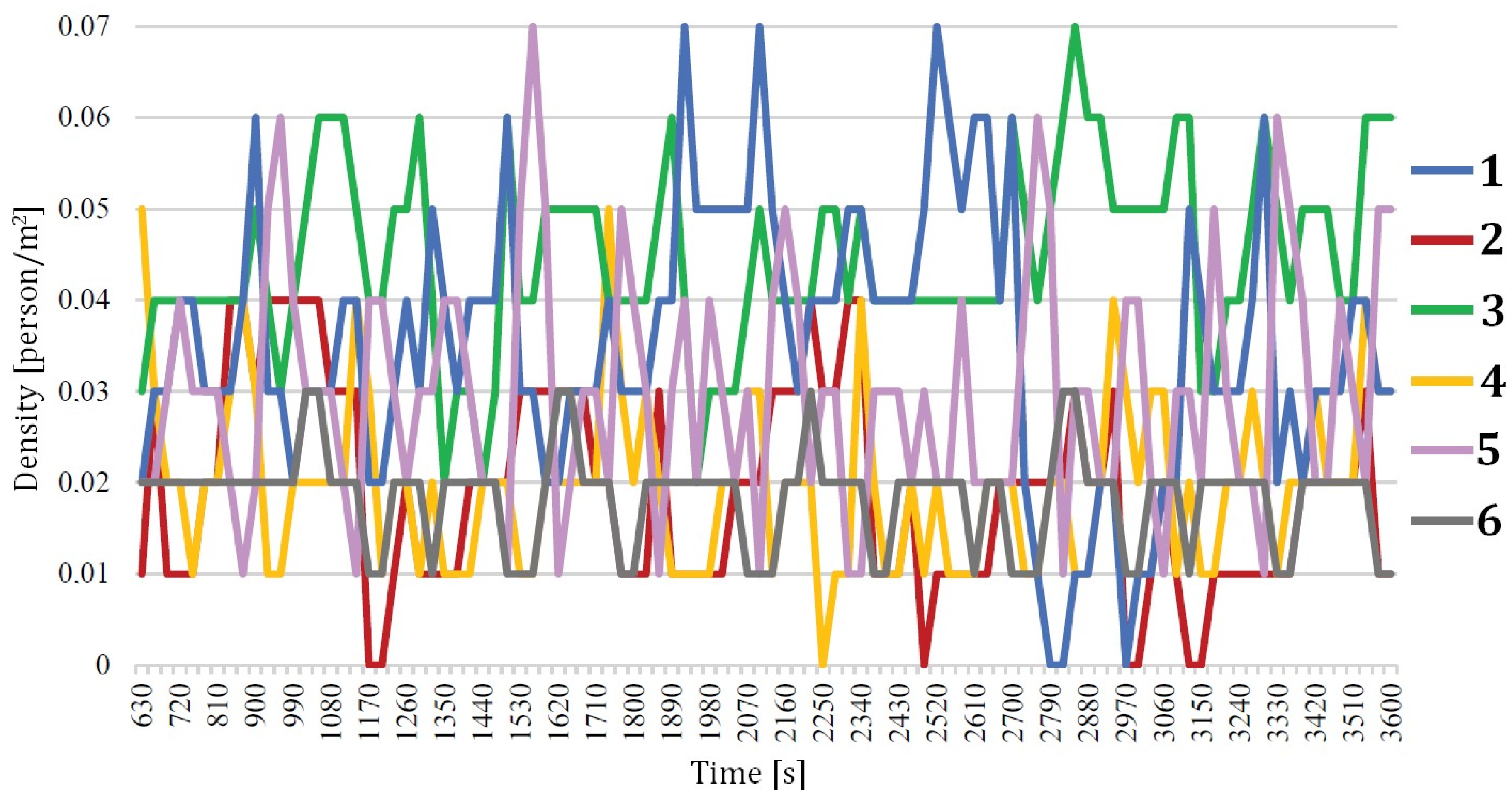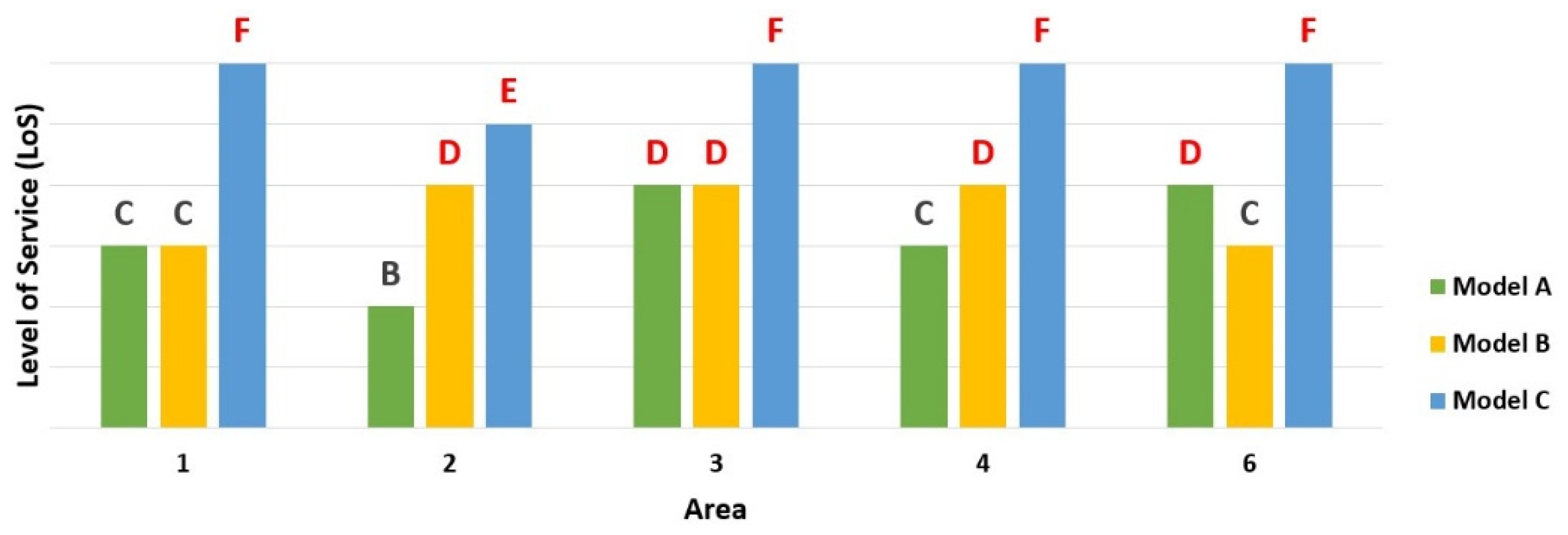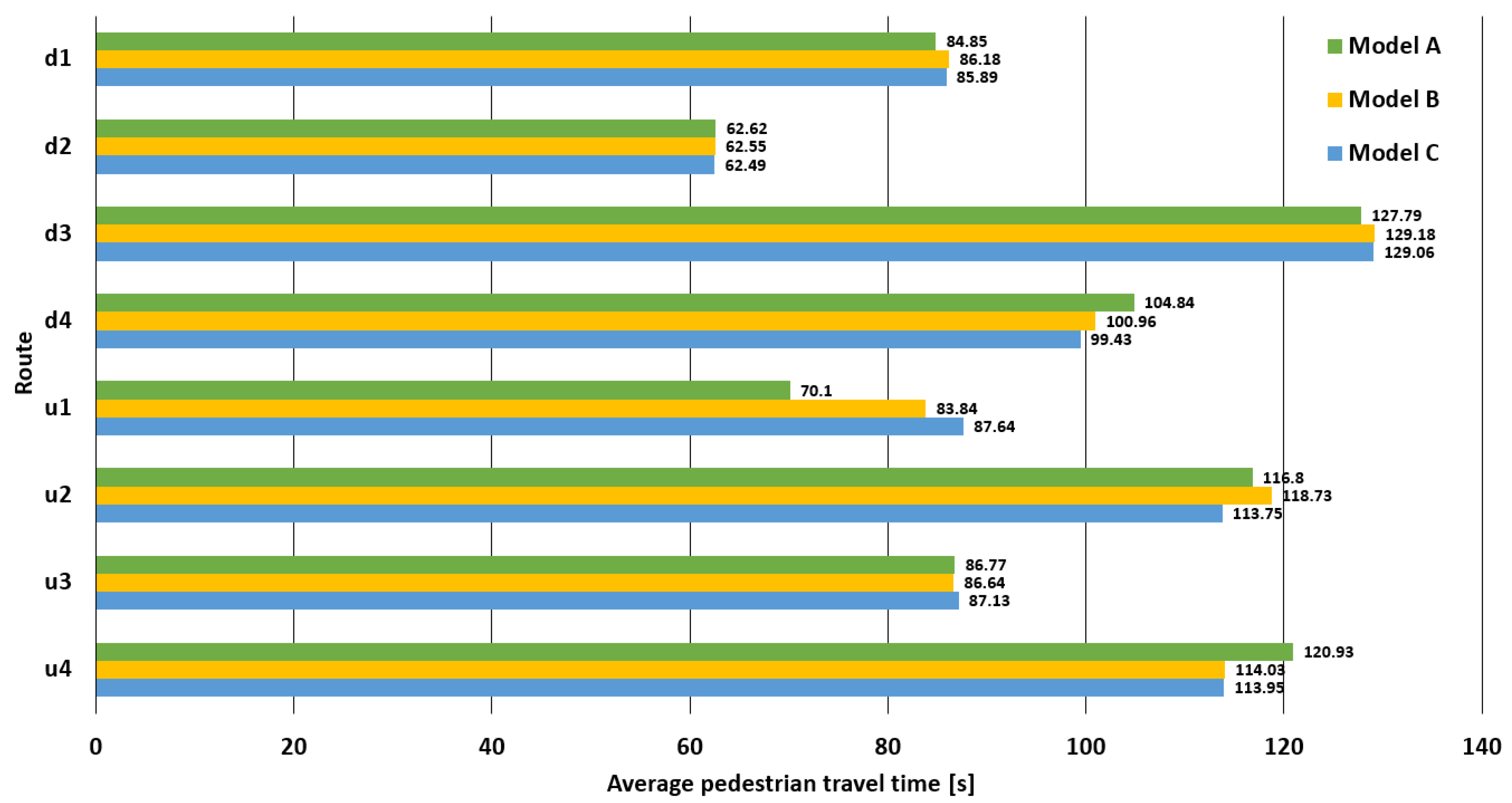1. Introduction
1.1. Sustainable and Accessible Transport
Sustainable development is about meeting a number of goals defined by the United Nations [
1,
2], such as no poverty and hunger, quality health care and education, sustainable cities and so on. The sustainability of cities is also very closely related to the transport sustainability, which tries to minimize the negative impact on the environment, traffic accidents, etc. It is mainly the support of such types of transport that have this effect as minimal as possible or at least less than the individual car transport (support of, e.g., pedestrian and cycle transport, public transport, etc.). However, the classic approach to traffic planning usually seeks to maximize mobility. For sustainable development, transport should be a means and not a goal. Cities, including their transport infrastructure, should be designed in such a way that unnecessary traffic is either completely eliminated or at least limited. The proposed solutions within sustainable transport must be reflected already in the phase of preparation, i.e., already in the design of transport structures [
3,
4,
5,
6,
7,
8,
9]. For example, roads must comply not only with valid regulations in the given country, but also with specific needs, i.e., contemporary modern turbo-roundabouts must also allow the passage of larger public transport vehicles [
10], passage of vehicles with excessive and oversized cargos [
11,
12], etc. An equally important issue in sustainable transport is traffic safety. For example, turbo-roundabouts often replace dangerous double-lane roundabouts with low sustainability capacity or level, as discussed in, e.g., [
13].
A separate chapter (and very important from the point of view of transport sustainability) is public transport sustainability. Functioning public transport is of fundamental importance, especially in large cities or densely populated agglomerations. Without quality and capacity public transport, such localities cannot function and any outage can cause the collapse of the entire city system. Therefore, a number of factors need to be monitored in the use of public transport. One of them is, for example, how a passenger is affected by the distance of a public transport stop from his home when choosing the means of transport used (i.e., the choice between public transport and individual car transport) [
14]. The passability of the access road to the nearest stop can also be crucial [
15]. Other factors may be, e.g., the number of connections of a given transport link, the waiting time for the next connection, the number of links of public transport between individual municipalities [
16], etc. These and other factors are very important for public transport accessibility [
17,
18].
In addition to the above-mentioned factors, it is also necessary to monitor other critical points of the public transport network, such as transit nodes. Similar to intersections in the road network where it has to cope with volumes of vehicles moving in different directions with different driving characteristics, the transit nodes are loaded by pedestrians moving in different directions and speeds. The quality of the transit node can be evaluated on the basis of the so-called Level of Service (LoS), which can be defined, e.g., by the average speed that pedestrians can reach (depending on the volume of pedestrians, dimensions of various parts of the transit node, i.e., corridors, stops, staircases, escalators, lifts, etc.), the pedestrian traffic density expressed in number of people per square meter, etc. These parameters also affect the so-called pedestrian travel times.
Capacity evaluation of transit nodes can be performed, e.g., on the basis of traffic surveys and following calculations. It can be relatively simple and fast. However, if, e.g., to find the optimal solution, we want to change the input parameters repeatedly and have results in the shortest possible time, it is necessary to use more sophisticated tools. Traffic modelling using specialized software can be used for this.
1.2. Research Aims
The article aims to confirm the hypothesis that microsimulation traffic models can be a very suitable tool for finding the optimal transport solution for critical points in public transport infrastructure, in order to ensure adequate transport accessibility and related transport sustainability—in other words, to present on a specific example of a loaded transit node the suitability (or a significant advantage) in the use of microsimulation traffic modelling, taking into account certain disadvantages in creating the model.
In fact, creating a microsimulation traffic model can be relatively time-consuming. However, it is very important to realize what purpose the model will serve, or how accurate the resulting traffic model should be. Naturally, no model can ever be a completely accurate copy of a modelled object or location. However, the more accurate the model we require, the more demanding its creation is. Analytic work with the resulting model then brings many significant advantages. For example, in case of the analysed transit node here, we can simply change the volumes of pedestrians and vehicles, make changes in the number of bus/tram connections or links, or change the speeds of escalators, etc. The mentioned changes can be made relatively quickly in the model, and it is also fast to obtain the desired results. It could be said that traffic models can be an invaluable aid in finding the optimal transport solution that respects the requirements for sustainable and accessible public transport.
However, it is necessary that traffic modelling is used when designing the given transport structure, but this fact is still often overlooked in the initial phase by investors, operators and, last but not the least, designers. Unfortunately, it often happens that the transport structure complies with all applicable regulations and standards, but traffic on it is problematic. Subsequently, remedial solutions are sought, unfortunately often at relatively high financial costs (i.e., greater than the creation of a traffic model). The aim of the research is to confirm the given hypothesis using a practical example of a microsimulation model of a specific transit node and to present the results of the research to the professional public.
1.3. The Structure of the Article
Section 2 contains a literature review dealing with the given issue.
Section 3 discusses both the traffic modelling in general and the microsimulation modelling programs PTV VISSIM and PTV VISWALK, which were used to evaluate the analysed transit node.
Section 4 presents the procedure of the performer analysis.
Section 5 describes the analysed transit node and its surroundings. Part of this section is also a description of the intention to expand the tram network with a new section on the tram line, which in the future will also affect traffic at the analysed transit node.
Section 6 deals with the input data and the results of the traffic surveys carried out. The evaluation of the capacity of the transit node according to the technical standard is described in
Section 7. This part is divided into the evaluation of pedestrian areas in various ways, as well as the evaluation of escalators and staircases.
Section 8 briefly introduces the microsimulation modelling program PTV VISSIM/VISWALK, which was used to evaluate the analysed transit node. The three models that were analysed are also described. More precisely, it is the same model that is subject to various loads (a model with normal load, a model taking into account the new tram line and a model at full load). The most extensive is
Section 9, which contains the results of the performed analyses. There are tables and graphs with descriptive comments. The conclusion and discussion follow.
2. Literature Review
The present article deals with the use of the PTV VISWALK microsimulation tool to find the optimal solution of the transit node in terms of ensuring sufficient capacity and degree of quality of transport (LoS), as a requirement for sustainable and accessible public transport.
In the research, the review of available literature was done, where we were looking for articles dealing with sustainable public transport, its critical points (with a focus on transit nodes) and the usage of microsimulation traffic models. For example, [
19] deals with the sustainability development of urban public transport, specifically the trolleybus system in chosen Polish cities, and [
20] deals with urban public transport accessibility, which addresses fair access to health services using public transport in the Chinese city Xi’an. The planning of the public transport system is addressed, for example, in [
21], which deals with the still evolving Munich Metropolitan Area; in [
22], which deals with the issue of chip cards; and in [
23], which uses the simulation program PTV VISUM. Other articles [
24,
25,
26,
27,
28] deal directly with the issue of transit nodes. For example, [
24] focuses on the issue of transfer between buses and metro in Chinese Beijing, [
25] deals with clusters of passengers at stops of public transport, [
26] introduces a library of classes created in Python, which can be used for computer simulation of transit nodes, and [
28] deals with the reduction of transfer times by optimizing public transport schedules. Although these articles deal with the above-mentioned topics, they always deal only with selected parts. On the other hand, sustainable public transport, transit nodes and microsimulation traffic models are dealt in, e.g., [
29], which, however, describes the issue of evacuation of the rail transit node.
Therefore, it can be stated that the present article brings a new perspective on the issue of using microsimulation traffic models within sustainable and accessible public transport.
4. Analysis Procedure
As indicated above, transit nodes can be critical points in the public transport network. Microsimulation models can be used to simulate traffic at transit nodes (not only road traffic, but especially pedestrian traffic). The present article points out, using a specific example, the possibility of using this tool for capacity evaluation of transit nodes. At our workplace within the Laboratory of Traffic Engineering, a microsimulation traffic model of the transit node, which is used by passengers for transfers between bus and tram transport, was created. It is a transit node, which is situated within a three-floor bridge structure. First, an initial simple model was created within the diploma thesis [
75] under the guidance of one of the authors of this article. Subsequently, within the laboratory, this model was modified, significantly refined and supplemented with other input data. The results of the analyses, which were performed on the basis of simulations performed on a model created in the PTV VISSIM/VISWALK program, are presented in this article.
Figure 1 shows a flowchart containing individual steps of the analysis. The whole process is divided into four basic parts, i.e., the initial preparation, creation of a simulation model, experimenting with the model and evaluation.
As part of the initial preparations, it is first necessary to relevantly describe the selected locality, including the surroundings. In the next step of the analysis, traffic problems are specified, while it is necessary to decide whether a suitable solution can be found using simulation tools. The most suitable type of model (microscopic/macroscopic, dynamic/static, etc.) is also selected here. Subsequently, the basic aims that the simulation process is to follow are set. Part of this step should be to decide about optional scenarios (i.e., to define different options of the model). The last step of this part is the collection and analysis of input data. This step can take place during the process of creating the model (often the input data must also be updated).
The next part concerns the creation of the simulation model itself [
76,
77]. The following part concerns the creation of the simulation model itself. One of the most important steps is to create a model concept. The correct methodology for model creation is selected, and the appropriate (or required) degree of abstraction of the analysed locality is determined. Then the basic traffic skeleton of the model is modelled, which can already be loaded with traffic. Only then other systems can be inserted into the model, such as public transport, pedestrian and bicycle transport systems, etc. However, it is pointless to create an excessively large model, as any small error can significantly influence the result of the simulation. We will then create our own simulation model from the conceptual model and later perform experiments on it. It is necessary to have at least basic knowledge of the relationships between generally accepted principles of modelling and their implementation in the modelling software used. Model verification means checking and verifying the functionality of the model. The functional characteristics of the model and their accuracy, compliance with physical laws, etc., are tested. It is suitable to perform the verification already during the creation of the model. The validation of the model is confirmed by the fact that the created model corresponds to the real model and provides appropriate results with the required degree of accuracy for the given purpose of the simulation study.
After creating the model and its successful verification and validation, it is possible to start experimenting with the model [
76,
77]. The design of the simulation process consists of the creation of plans of simulation experiments, i.e., the determination of the number of simulation experiments, their length and the method of performance. This is followed by the actual simulation and its evaluation. This is repeated depending on the specified number of simulations. If new problems or facts appear during experimentation that need to be taken into account in the model, it is necessary to determine a new design of the simulation process. After performing all planned simulations, the analysis of the obtained data follows.
The previous two stages (i.e., model creation and experimentation) are repeated in the case of more options of the model (in the present article, these are Models A, B and C).
In the final part, the evaluation of the results of analyses and the definition of conclusions are performed. The results of the experiments can be presented using tables or graphs and, if necessary, using appropriate statistical tools, but always taking into account the purpose of the simulation study. In the case of creating more options models, a comparison of the results of the analysis for all models is performed.
6. Traffic Surveys
The basic input data for the analyses were pedestrian volumes. Passengers can enter the monitored transit node areas in two ways, i.e., they come from the surrounding area or arrive by public transport vehicles. From the surrounding area, passengers can come from the north (i.e., in the place of the northern staircase tower—see
Figure 4, position 1), or from the south (i.e., in the place of the southern staircase tower—see
Figure 4, position 3). These places were subsequently defined in the traffic model as the so-called pedestrian inputs. The pedestrian volumes found by the research in the afternoon peak hour are stated in
Table 1.
Traffic volumes of departing and boarding passengers were obtained from the data obtained by the company KODIS [
79], or from [
75]. These were passengers of urban and long-distance bus links, as well as passengers of tram links. Due to copyright, a sample of the data obtained cannot be published in this article. Therefore, we limit ourselves to a verbal description. The direction and number of the link, the time of the connection, the number of passengers who arrived, disembarked, boarded and departed, and the maximum vehicle occupancy and its capacity utilization in percentage were stated for each connection of the given transport link. Regarding the number of connections, for example, in the afternoon peak hours on a working day (3 p.m.–4 p.m.), 36 tram connections were recorded in the direction to the district Poruba (see
Figure 4—position T1), 37 tram connections in the direction to the city centre (see
Figure 4—position T2), 32 bus connections in the direction to Poruba (see
Figure 4—position H1–H4) and 34 bus connections in the direction to the city centre (see
Figure 4—position H5–H8). From the stops on the ground floor of this transit node, 22 connections departed from stop D1 and 16 connections departed from stop D2 (see
Figure 4—position D1 + D2). For illustration, we present the number of transport links that pass through the relevant stops (as indicated in
Figure 4): T1—5 links, T2—5 links, H1—1 link, H2—3 links, H3—3 links, H4—1 link, H5—1 link, H6—1 link, H7 –3 links, H8—3 links, D1—14 links and D2—13 links (stops H1 and H5 are served mainly by the long-distance links; a larger number of long-distance links is also at stops D1 and D2).
These data had to be supplemented by our own traffic surveys, which focused on the transfers of passengers between individual means of transport (or between individual floors of the transit node) during transfers from link to link. In other words, it was necessary to analyse the movements of passengers between floors, the usage of stairs, escalators and lifts, etc. For this purpose, informed people were used. They conducted the census. Video cameras were also used. Due to the large content of the obtained data, we limit the discussion to only the sample shown in
Table 2. The table shows the number of passengers using stairs S1–S7 and escalators E1–E6 (see
Figure 4 for designation), again during the afternoon peak hours (3 p.m.–4 p.m.), which was eventually used in a microsimulation traffic model. Greater usage of escalators is evident (compared to staircases), as due to the importance of this transit node, there are a larger number of passengers with larger luggage (suitcases, etc.). Due to the minimal usage of lifts (on average, 4 people/h per lift), the capacities of the lifts were not evaluated in the analyses.
The traffic model also needed to take into account the composition of pedestrian traffic, which is closely related to walking speed. The usual walking speed of a healthy adult on a plain is about 5 km/h. However, this problem is not so clear-cut. It is necessary to take into account, for example, the proportion of older people, people with special needs, etc. The PTV VISSIM/VISWALK program uses the so-called speed distribution function, which takes into account the age of the pedestrians and their possible reduced mobility.
Table 3 shows the lower and upper speed limits for the individual pedestrian classes as well as the percentages used in the analysed models. These percentages were determined on the basis of video recordings taken as a part of traffic surveys. Since transport is basically a stochastic system, these adjustments are sufficient for the needs of the described analyses. The real speed of movement of individual pedestrians is naturally influenced (usually reduced) in the model by a number of factors, e.g., avoiding obstacles and other pedestrians, taking the stairs or using escalators, etc.
For the needs of traffic models, it was also necessary to find out the number of car transport vehicles that pass on roads and can affect departures of buses from stops. The volume of vehicles passing bus stops on the 2nd floor (i.e., H1–H8—see
Figure 4) is about 5000 vehicles per peak hour. The volumes of vehicles at stops D1 + D2 on the ground floor is basically negligible (approx. 100 veh/h).
10. Discussion and Conclusions
The article uses a specific example of complex transit node between bus and tram transport to analyse the transfers of passengers using a microsimulation traffic model created in the PTV VISSIM/VISWALK program. The created model was loaded in three ways: Model A with normal vehicle and passenger volumes, Model B took into account the extension of the existing tram network by a new line, and Model C, which was loaded with extraordinary volumes that may occur during cultural or sports events.
The analyses focused on the evaluation of the Level of Service or on capacity reserves, and various parts of the transit node, i.e., areas intended for movement and waiting (clusters) of passengers, escalators and fixed staircases. Each model was also analysed in terms of travel times of people. From the results given in
Section 9 (or see the overall evaluation in
Section 9.5), it follows that the analysed transit node is in all observed aspects satisfactory, even in the case of Model C, which is loaded with extraordinary volumes. Certain not excellent results are in case of evaluation of Level of Service for areas used by passengers waiting for a bus/tram connection (especially for Model C), which was expected because in case of extraordinary events, clusters of people at stops are common. In addition, this condition occurs exceptionally.
Although the results presented in the previous sections show that the analysed transit node is suitable in terms of capacity, largely even under extraordinary load, it is always appropriate to think about whether it is realistic, or useful, to increase the capacity (if possible, without significant construction modifications or at high financial costs). If we look, for example, at how the capacity of a standard transport structure can be increased, such as a road or an intersection, it is often the case that additional lanes are added, or these lanes are widened, etc. However, this often leads to disproportionate land use, high financial investments, etc. This trend is certainly not in compliance with transport sustainability, as mentioned in the introduction of this article. In the case of a transit node, in order to increase the capacity of pedestrian areas (either areas for the movement of passengers or areas intended for passengers waiting for a bus/tram connection), or escalators and staircases, their dimension could be increased. However, this is in conflict with what is mentioned earlier, i.e., that there would be expensive construction modifications, which, for example, would not even be possible in the case of the analysed transit node (three-level bridge structure).
It is worth considering increasing the capacity of escalators. Due to their fixed width and the speed of staircases, it can happen that in the case of, for example, a significant jump in pedestrian volumes, the capacity of the escalator will be exceeded. Fortunately for the analysed transit node, the occurrence of this danger is compensated by the fact that there is a standard staircase with sufficient width near each escalator (however, this may not generally be the case). One way to increase the capacity of escalators is to increase their nominal speed. The escalators of the analysed transit node are designed for a nominal speed of 0.5 m/s, and their constructional arrangement does not allow to increase their speed [
75]. In the case of a requirement for a higher nominal speed of escalators, the design of the track system, chains, drives, etc., would have to be modified. This would, among other things, result in a change in the dimensions of the escalator design itself (requirement CSN EN 115 [
83]). Although this European standard allows solutions with a speed of up to 0.75 m/s (see
Table 6), this cannot be applied to the escalators of the analysed transit node, for the reasons stated above. Changing the dimensions of escalators (i.e., changing the length, width and inclination) would again mean financially demanding modifications, which would also not be possible from a construction point of view. For interest, we state here that escalators with a higher nominal speed of 0.75 m/s are used, for example, in the underground of the capital Prague, where, however, there are much higher passenger volumes compared to the transit node we are monitoring. It is also worth considering that higher escalator speeds can cause passengers to keep more distance (for example, for personal safety reasons) and that the actual capacity of the escalator may decrease. People with reduced mobility may also have problems using escalators with higher nominal speeds.
There is also consideration (even commonly practised in some cities) as to whether the capacity of escalators could not be increased by “optically splitting” the escalator into left and right parts (in the direction of movement). In one part, passengers would stand and in the other, faster passengers could “run up/run down” the escalators. However, the experience is that there is a rather negligible increase in the capacity of the escalator. This practice presents problems for escalator operators, as there is more wear on the moving components in the part where the passengers are standing [
75], which can cause fault in the escalator and eventually endanger the functionality of the entire transit node. It should be noted that the PTV VISSIM/VISWALK program allows the option of using both sides of the escalators.
On the example of a specific transit node with bus and tram transport, which is built on a bridge construction with three height levels, the use of microsimulation traffic modelling for the capacity evaluation of the transit node was shown. The creation of the model itself is a relatively time-consuming work, which, however, depends on how accurate we want this model, or we need to have. Naturally, the model will never be, and cannot be, an absolutely exact copy of the real world or its parts (here the transit node). It mainly depends on the purpose for which the created model is to be used. The more complicated, or accurate model we require, the more difficult it is to create.
However, subsequent work with the final model (i.e., loading with different volumes of pedestrians and vehicles, making changes in the number of bus/tram connections or links, or changes of the speed of escalators, etc.) brings many significant advantages. These changes can be made relatively quickly in the model (the condition is, of course, to have the appropriate data), and it is also fast to obtain results from the simulations. For example, the PTV VISSIM/VISWALK program performs hourly simulations as standard, which can be “accelerated” when starting this program so that the relevant results are available in about 5 min. This operability is one of the main advantages of microsimulation traffic models, which significantly exceeds the disadvantages associated with long model creation.
The examples given in this article are only a fraction of how the created model of the analysed transit node could be used. A number of other examples of usage could be found, such as using the model to find the optimal solution for timetable changes (which usually occur at the beginning of the year and during the summer holidays) so that the capacity of the transit node is not exceeded and its functionality disrupted. We also see the use of the model at this time influenced by the COVID-19 pandemic, when using the model can well and quickly find optimal solution for the number of connections and sequential arrivals/departures of bus/tram connections to and from stops, so as larger groups of people do not gather together as a part of hygiene measures. The main task of the article was then to point out that the use of microsimulation traffic models can be an important part in the design of transport structures to ensure both the availability of public transport and the required sustainability. Of course, the reality may be different in the end, but the results from the traffic models give us a certain idea of the behaviour of the traffic on the monitored transport structure.
The performed analyses at the transit node are a very important basis for further development of the solved locality. As already mentioned, the location is close to the passenger train station. At present, major changes are planned here in terms of track routing and in the overall modification of the transit node. A high-speed railway is also planned in the locality, which will have a stop at this train station. The overall modification of the railway connection may affect the intensity of pedestrian traffic at the modelled transit node. Furthermore, in the locality between the analysed transit node and the train station, the construction of a three-storey multifunctional building is planned, in which shops, restaurants, etc. will be located. And it will be followed by a 12-storey administrative building. It is obvious that there will be an increase in interest in this locality from the point of view of pedestrians and public transport. Therefore, this model is already properly prepared and tested for future input of relevant data. These requirements were not taken into account in the performed simulations, as the necessary data are currently being collected as part of the construction preparation.
In the Czech Republic, it is not a common practice to use traffic models to simulate the movement of people in such important transport structures. Rather, models related to traffic at intersections, models of evacuation of people, etc., are used. Therefore, the present article dealt with research and the given hypothesis, whether it is possible in our conditions to relevantly use the traffic modelling of the transit node, so that the model is sufficiently effective and ready for further future use.
The presented analysis concerning the capacity evaluation of a chosen transit node using the microsimulation traffic model created in the PTV VISSIM/VISWALK program thus confirms the hypothesis stated in the introduction of this article. Microsimulation traffic models are undoubtedly a suitable tool that can be used in the search for the optimal transport solution of critical points of the public transport network to ensure adequate transport accessibility and related transport sustainability.
